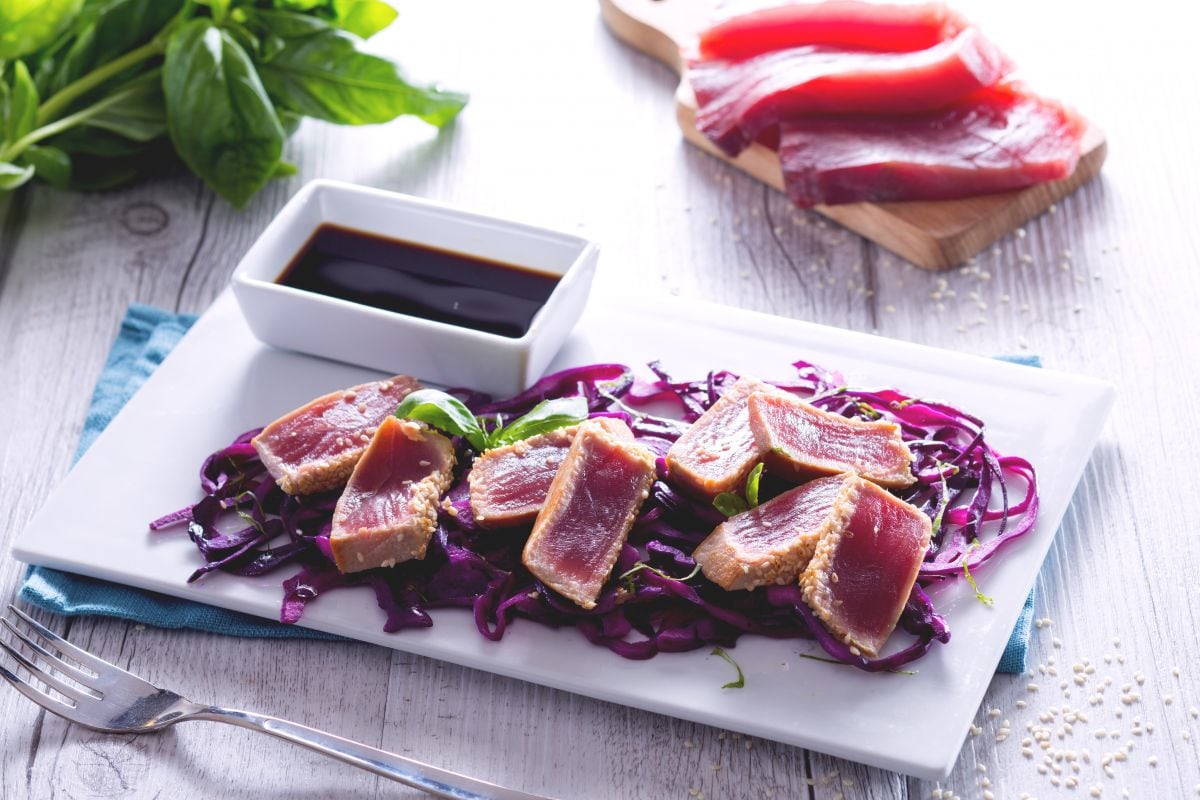Soy-Glazed Tuna

- Lactose Free
- Energy Kcal 280
- Carbohydrates g 5.6
- of which sugars g 3.7
- Protein g 26.3
- Fats g 17
- of which saturated fat g 4.61
- Fiber g 1.4
- Cholesterol mg 70
- Sodium mg 3720
- Difficulty: Easy
- Prep time: 15 min
- Cook time: 15 min
- Serving: 4
- Cost: Average
- Note + 1 hour of marination
PRESENTATION
If you’re wanting a taste of Japan right at home, this glazed tuna dish is a great pick. Really good stuff. It combines the deep flavors of a soy sauce glaze with a sprinkle of crunchy sesame seeds. This isn't just about taste; it's an experience. The dish draws from Japanese cuisine with touches like tuna tataki. And look, the glaze gives the tuna a beautiful, golden shine and a sticky coating. That combo with its tender interior? Pretty much what makes it special. Adding sesame seeds not only makes it look good—really, it does—but also adds a crunch that complements the soft fish just perfectly.
Across Japan, this seared tuna recipe often gets a simple splash of soy sauce glaze to let the fish's natural flavors shine through. But truthfully, it’s super easy to jazz it up. A touch of honey? For sure. That makes a quick honey soy glaze, bringing out the tuna's sweet notes. Plus, some folks grill tuna steaks on the barbecue, finishing them with the glaze for a smoky twist. No question about it, however you serve it, this dish fits nicely into any weeknight meal or even a spontaneous gathering. It's quick, simple, and you’ve got room to experiment. Try toppings like toasted sesame or even a fusion of Mediterranean and Asian elements. From the first moist bite to the last tangy drop of sauce, this glazed tuna is a healthy choice that really, really never gets old. Whether you're a fan of traditional flavors or love mixing things up, this recipe promises to deliver a delicious, memorable meal every time. So here's the deal: why not give it a shot and enjoy a bit of Japan at your dinner table tonight?
You might also like:
- INGREDIENTS
- Tuna 0.9 lb (400 g) - fillet
- Red cabbage 1.1 lbs (500 g)
- Soy sauce ¼ cup (50 g)
- White wine vinegar 0.4 cup (100 g)
- Fine salt 5 ¼ tsp (30 g)
- Extra virgin olive oil 1 ½ tbsp (20 g)
- Basil 4 leaves
- Sesame seeds 10 tsp (30 g)
How to prepare Soy-Glazed Tuna

To prepare the soy-glazed tuna, start with the vegetables: julienne the cabbage 1 and place it in a bowl, drizzling with white wine vinegar 2 and seasoning with salt 3.

Mix the ingredients well and let them macerate for at least 1 hour, covering with clear plastic wrap 4. After this time, drain and rinse the cabbage thoroughly under plenty of running water 5. Then cook it in a non-stick pan where you have heated 1 tbsp of oil 6.

Flavor with some well-washed and dried basil leaves 7 and cover with a lid 8, cooking over low heat for about 10 minutes. At the end of the cooking time, the cabbage should still be crunchy. While the cabbage cooks, focus on the tuna. Take a small bowl and pour the soy sauce 9.

Handle the tuna: make sure you have a pre-frozen filet; we recommend freezing the filet for at least 96 hours at 0°F and then thawing for preparation. Cut the tuna into slices about 1.5 inches thick 10. Then, place a small bowl containing the white sesame seeds next to the soy sauce. Take a slice of tuna and coat all sides with the soy sauce 11, then completely cover the long sides of the tuna slice with the sesame seeds 12. Repeat the process with all the tuna slices.

Now take a non-stick pan and pour in 1 tsp of oil: heat it and place the tuna slices on their long sides 13. Sear the tuna slices for about 2 minutes, then turn them over to cook the other side for an additional 2 minutes 14. For even cooking, you can also sear the sides of the tuna slices for 1 minute each 15.

Place a bed of cabbage on a serving plate 16 and arrange the tuna slices on top of it, serving with the soy sauce 17. Your soy-glazed tuna is now ready to be served and enjoyed 18.